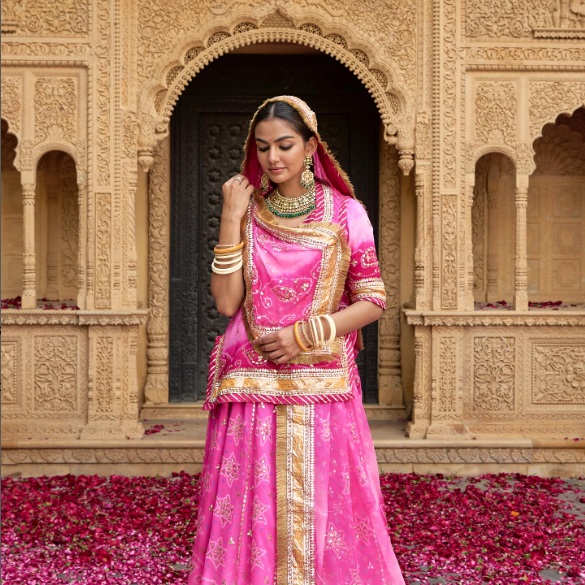In the kaleidoscope of India's rich cultural heritage, the Rajputani poshak stands out as a timeless symbol of elegance and tradition. Adorned by the women of Rajasthan, particularly the Rajput community, this attire is a captivating blend of intricate craftsmanship, vibrant colors, and historical significance. Delving into the world of Rajputani poshak unveils not just a garment but a narrative woven with threads of heritage, artistry, and grace.
Origins and Evolution
The roots of the Rajputani poshak trace back centuries, mirroring the lifestyle and ethos of Rajasthan's noble Rajput clans. Originally, these garments were designed to reflect the regal stature of Rajput women, incorporating elements that denoted status, culture, and region. Over time, the poshak evolved, influenced by changing fashion trends, cultural exchanges, and the artisans' creativity.
Elements of Rajputani Poshak
Ghagra/Lehenga: The central piece of a Rajputani poshak, the ghagra or lehenga, is a voluminous skirt that adds grandeur to the attire. It is often embellished with intricate embroidery, mirror work, and gota patti, reflecting the artisan's skill and creativity.
Choli: The choli, or blouse, complements the ghagra. Traditionally, it is designed with intricate patterns and embellishments, showcasing the wearer's heritage and style. The choli's design can vary from simple to elaborate, depending on the occasion and personal preferences.
Odhi/Dupatta: The odhi or dupatta is a versatile piece that completes the Rajputani poshak ensemble. It is draped elegantly over the shoulder or head, adding a touch of grace and modesty. The odhi is often adorned with intricate embroidery, tassels, and borders, enhancing its beauty.
Jewelry: No Rajputani poshak is complete without exquisite jewelry. From the elaborate maang tikka adorning the forehead to the ornate necklaces, bangles, and waistbands, each piece of jewelry holds cultural significance and adds to the poshak's allure.
Embroidery and Embellishments: Rajputani poshaks are renowned for their intricate embroidery and embellishments. Artisans skillfully incorporate traditional motifs such as peacocks, elephants, flowers, and geometric patterns, creating stunning visual narratives on the fabric.
Cultural Significance
The Rajputani poshak goes beyond being a mere garment; it is a symbol of cultural pride and identity. Each element of the poshak, from the choice of colors to the embroidery patterns, reflects the wearer's lineage, region, and traditions. It is often worn during auspicious occasions such as weddings, festivals like Teej and Diwali, and cultural celebrations, where it becomes a testament to the rich heritage of Rajasthan.
Regional Variations
Rajasthan's diverse regions contribute to the richness and diversity of Rajputani poshaks. For instance:
Jaipuri Poshak: Known for its vibrant colors, intricate block printing, and tie-dye techniques like bandhani, Jaipuri poshaks exude a festive charm and are popular choices for celebrations.
Marwari Poshak: Reflecting the Marwari community's heritage, these poshaks often feature rich embroidery, mirror work, and bright hues like red and green, symbolizing prosperity and joy.
Mewari Poshak: Mewar's poshaks are known for their elegance and royal appeal. They often incorporate zardozi work, silk fabrics, and intricate motifs inspired by Mewar's art and architecture.
Bikaneri Poshak: Influenced by Bikaner's cultural tapestry, these poshaks are characterized by vibrant colors, detailed thread work, and embellishments like sequins and beads, adding a touch of glamour.
Contemporary Revival
While deeply rooted in tradition, Rajputani poshaks have also embraced modern influences. Contemporary designers are reimagining these garments, blending traditional craftsmanship with contemporary silhouettes, fabrics, and styling. This fusion has revitalized interest in Rajputani poshaks among younger generations, making them a choice not just for cultural events but also for fashion statements that celebrate heritage.
Revival of Handicrafts
The resurgence of Rajputani poshaks has also contributed to the revival of traditional handicrafts and artisanal skills. Artisans specializing in embroidery, tie-dye, block printing, and jewelry making find renewed demand for their craft, ensuring the preservation of these age-old techniques for generations to come.
Wider Influence and Global Appeal
Beyond Rajasthan, the allure of Rajputani poshaks has transcended borders, captivating fashion enthusiasts and designers worldwide. The intricate craftsmanship, vibrant colors, and historical narratives woven into these garments make them sought-after pieces for cultural events, fashion shows, and weddings, adding a touch of heritage and elegance to global fashion scenes.
Conclusion
In the tapestry of India's cultural diversity, the Rajputani poshak shines as a radiant thread, connecting heritage with contemporary allure. Its timeless charm, intricate craftsmanship, and cultural significance continue to fascinate and inspire, making it not just a garment but a cherished legacy passed down through generations. Embracing a Rajputani poshak is not merely donning attire; it is embodying a rich narrative of tradition, artistry, and elegance—a journey through time that celebrates the essence of Rajasthan's cultural heritage.
For more info:- leheriya saree





Comments